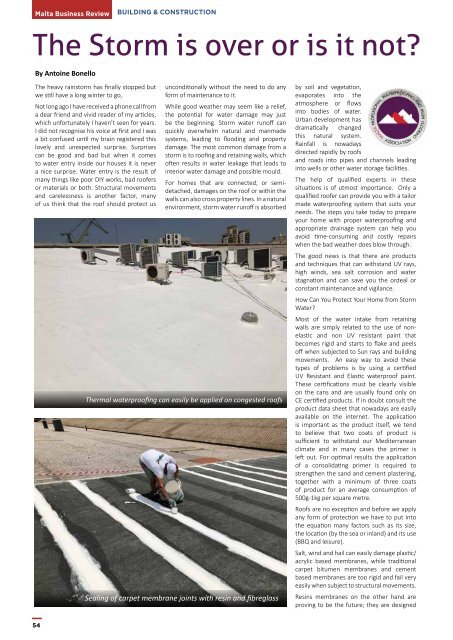MBR final low res
You also want an ePaper? Increase the reach of your titles
YUMPU automatically turns print PDFs into web optimized ePapers that Google loves.
Malta Business Review<br />
BUILDING & CONSTRUCTION<br />
The Storm is over or is it not?<br />
By Antoine Bonello<br />
The heavy rainstorm has <strong>final</strong>ly stopped but<br />
we still have a long winter to go,<br />
Not long ago I have received a phone call from<br />
a dear friend and vivid reader of my articles,<br />
which unfortunately I haven’t seen for years.<br />
I did not recognise his voice at first and I was<br />
a bit confused until my brain registered this<br />
lovely and unexpected surprise. Surprises<br />
can be good and bad but when it comes<br />
to water entry inside our houses it is never<br />
a nice surprise. Water entry is the <strong>res</strong>ult of<br />
many things like poor DIY works, bad roofers<br />
or materials or both. Structural movements<br />
and carelessness is another factor, many<br />
of us think that the roof should protect us<br />
unconditionally without the need to do any<br />
form of maintenance to it.<br />
While good weather may seem like a relief,<br />
the potential for water damage may just<br />
be the beginning. Storm water runoff can<br />
quickly overwhelm natural and manmade<br />
systems, leading to flooding and property<br />
damage. The most common damage from a<br />
storm is to roofing and retaining walls, which<br />
often <strong>res</strong>ults in water leakage that leads to<br />
interior water damage and possible mould.<br />
For homes that are connected, or semidetached,<br />
damages on the roof or within the<br />
walls can also cross property lines. In a natural<br />
environment, storm water runoff is absorbed<br />
Thermal waterproofing can easily be applied on congested roofs<br />
Sealing of carpet membrane joints with <strong>res</strong>in and fibreglass<br />
by soil and vegetation,<br />
evaporates into the<br />
atmosphere or f<strong>low</strong>s<br />
into bodies of water.<br />
Urban development has<br />
dramatically changed<br />
this natural system.<br />
Rainfall is nowadays<br />
directed rapidly by roofs<br />
and roads into pipes and channels leading<br />
into wells or other water storage facilities.<br />
The help of qualified experts in these<br />
situations is of utmost importance. Only a<br />
qualified roofer can provide you with a tailor<br />
made waterproofing system that suits your<br />
needs. The steps you take today to prepare<br />
your home with proper waterproofing and<br />
appropriate drainage system can help you<br />
avoid time-consuming and costly repairs<br />
when the bad weather does b<strong>low</strong> through.<br />
The good news is that there are products<br />
and techniques that can withstand UV rays,<br />
high winds, sea salt corrosion and water<br />
stagnation and can save you the ordeal or<br />
constant maintenance and vigilance.<br />
How Can You Protect Your Home from Storm<br />
Water?<br />
Most of the water intake from retaining<br />
walls are simply related to the use of nonelastic<br />
and non UV <strong>res</strong>istant paint that<br />
becomes rigid and starts to flake and peels<br />
off when subjected to Sun rays and building<br />
movements. An easy way to avoid these<br />
types of problems is by using a certified<br />
UV Resistant and Elastic waterproof paint.<br />
These certifications must be clearly visible<br />
on the cans and are usually found only on<br />
CE certified products. If in doubt consult the<br />
product data sheet that nowadays are easily<br />
available on the internet. The application<br />
is important as the product itself, we tend<br />
to believe that two coats of product is<br />
sufficient to withstand our Mediterranean<br />
climate and in many cases the primer is<br />
left out. For optimal <strong>res</strong>ults the application<br />
of a consolidating primer is required to<br />
strengthen the sand and cement plastering,<br />
together with a minimum of three coats<br />
of product for an average consumption of<br />
500g-1kg per square metre.<br />
Roofs are no exception and before we apply<br />
any form of protection we have to put into<br />
the equation many factors such as its size,<br />
the location (by the sea or inland) and its use<br />
(BBQ and leisure).<br />
Salt, wind and hail can easily damage plastic/<br />
acrylic based membranes, while traditional<br />
carpet bitumen membranes and cement<br />
based membranes are too rigid and fail very<br />
easily when subject to structural movements.<br />
Resins membranes on the other hand are<br />
proving to be the future; they are designed<br />
54

















